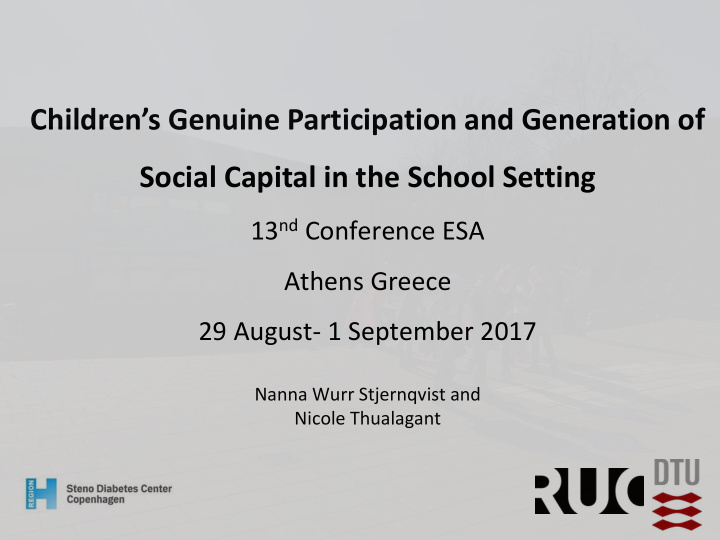



Children’s Genuine Participation and Generation of Social Capital in the School Setting 13 nd Conference ESA Athens Greece 29 August- 1 September 2017 Nanna Wurr Stjernqvist and Nicole Thualagant
Agenda • Setting the scene • Theoretical construct • Study design and analytical approach • Findings • Discussion
Why social capital? Social capital as a potential lever for policy actions Knowledge gab How may social capital be generated in the school as setting and with children as active participants'?
Aim of the study To contribute to the conceptualization of the mechanisms for children’s development of social capital in the school setting focusing on children’s participation from a democratic educational perspective
Theoretical Construct - Social Capital The social cohesion approach – Social capital as a mainly collective asset The new sociology of childhood – A more ‘active’ conceptualization of children – Focus on practices and bonding, bridging and linking social capital
Theoretical Construct - Participation Democratic Health Education Token participation • Specific content that has to be learned, accepted and utilized Genuine participation • Students are involved in decision making Simovska, V. 2007. The changing meanings of participation in school-based health education and health promotion: the participants’ voices. Health Education Research , 22(6), pp.864 – 878. Hart, R.A. 1997.
Study design and analytical process Qualitative data design Abductive reasoning strategy Two different cases/pupil schools located in Denmark to discern common patterns SCHOOL B SCHOOL A Focus group interviews Pilot test with 2 groups (8 Pilot test children) 4 Focus 6 Focus 10 focus groups with 44 children groups groups
Methods Semi-structured moderator guide Photo elicited interview technique
Findings
Concluding remarks • Thus we propose a nuanced depiction of the mechanisms of social capital generation where focus is set on the contextual embeddedness of social capital – Difficulty to depict cause and effect – Different modes of participation different types of social capital – Social capital as a process instead of an output
Questions for discussion Theoretical consideration Practical consideration • How can this exploration be • How can this exploration be relevant for other welfare transferred into a practical regimes? educational context?
Acknowledgement • Co-authors and supervisors: Inge Tetens 1,5, Helle Terkildsen Maindal 2, Marianne Sabinsky 1, Bjarne Bruun Jensen 2 and Ellen Trolle 1 • Ane Høstgaard Bonde 2, Dina Danielsen previous employed 2 and 3 , Ida Foxvig previous employed 2 and Maria Bruselius-Jensen 2 , 4 • The participatory children • The National Food Institute, the Technical University of Denmark - and Steno Health Promotion Research Diabetes Center Copenhagen for financial support 1 National Food Institute, Technical University of Denmark, DK 2 Steno – Health Promotion Research, Steno Diabetes Center Copenhagen, DK 3 Department of People and Technology Roskilde University, DK 4 Center for Youth Research, Aalborg University, DK 5 Preventive and Clinical Nutrition, Copenhagen University, DK
Recommend
More recommend